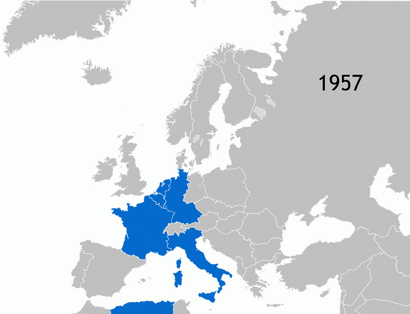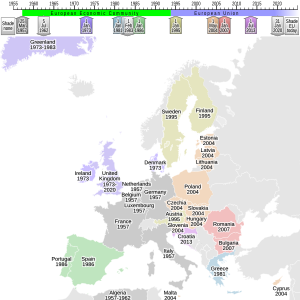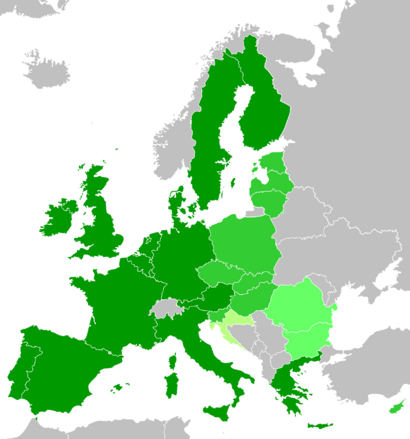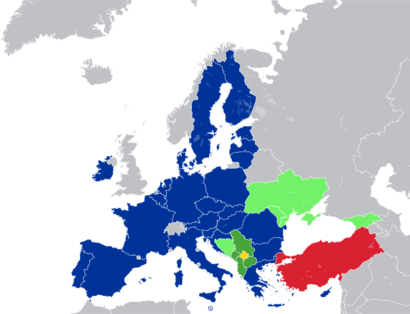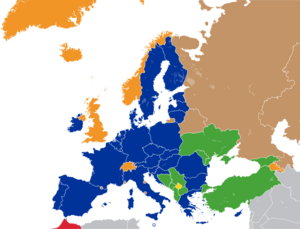Enlargement of the European Union facts for kids
The European Union (EU) is like a big team of countries in Europe that work together. Over the years, more and more countries have joined this team. This process of new countries joining is called "enlargement."
To join the EU, a country needs to meet certain rules called the Copenhagen criteria. These rules make sure the country has a stable government that respects democracy, human rights, and the rule of law. It also needs a strong market economy. Every country already in the EU and the European Parliament must agree before a new country can join. This whole process of countries joining and working more closely together is also known as European integration.
The EU started small in 1958 with six countries, often called the "Inner Six". Since then, it has grown to twenty-seven member countries. The newest country to join was Croatia in July 2013. Sometimes, parts of existing EU countries also join the EU Customs Union, like Mayotte in 2014 and Campione d'Italia in 2020.
The EU has also seen some areas leave. For example, Algeria left in 1962 when it became independent, Greenland left in 1985, and the United Kingdom left in 2020 (this was called Brexit).
Currently, several countries are working towards joining the EU. These include Montenegro (since 2012), Serbia (since 2014), Albania (since 2020), North Macedonia (since 2020), Moldova (since 2024), and Ukraine (since 2024). Talks with Turkey started in 2005 but have been paused since 2016 because of concerns about democracy and rights there.
Bosnia and Herzegovina and Georgia are also official candidates, meaning they are on the path to joining, but they need to make more changes first. Kosovo applied to join in December 2022, but not all EU countries recognize it as an independent state, which makes its path to membership more complicated.
Contents
What Countries Need to Join the EU
The EU rules say that any European country can join if it believes in and promotes values like human dignity, freedom, democracy, equality, the rule of law, and human rights. These ideas come from the "Copenhagen criteria" agreed upon in 1993. These criteria were created when many countries from the former Eastern Bloc (countries that were once under Soviet influence) wanted to join.
Here's what the Copenhagen criteria mean:
- A country must have stable democratic institutions. This means a government that respects the rule of law, human rights, and protects minorities.
- It needs a working market economy that can handle competition within the EU.
- The country must be able to take on all the responsibilities of being an EU member, including following EU laws and supporting the EU's goals for political and economic unity.
In 1995, another rule was added: countries must also adjust their government systems to effectively put EU laws into practice. This means their laws and courts need to be ready to follow EU rules.
Finally, all new members must adopt the acquis communautaire. This is a French term for all the laws, rules, and agreements that the EU has built up over its history. New members must make their own laws match these EU laws.
How Countries Join the EU
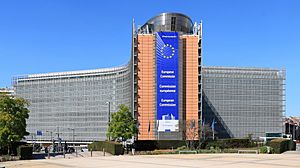
Joining the EU involves several official steps. The European Commission plays a big role in this, but the actual talks happen between the EU member countries and the country that wants to join.
Before a country even applies, it often signs an association agreement. This helps the country get ready for the process, as many countries need years to meet the basic requirements. For countries in the Western Balkans, there's a special process called the Stabilisation and Association Process to help them.
When a country officially applies, the EU's Council asks the European Commission to check if the country is ready to start talks. If the Council agrees, the "screening process" begins. During this, the Commission and the candidate country compare their laws to EU laws to see what needs to change.
Then, negotiations start on different "chapters" of law. A chapter is like a topic area, such as environmental law or financial rules. The goal is for the candidate country to show it can apply EU laws effectively. Sometimes, they agree on a timeline for when certain EU rules must be fully in place.
A chapter is "closed" when both sides agree the country has met the requirements. However, it can be reopened if the Commission feels the country is no longer following the rules.
The European Commission checks on the progress of candidate countries every year and sends reports to the European Council. These reports help the Council decide whether to continue or expand negotiations.
Once all the talks are finished, a special agreement called a Treaty of Accession is signed. This treaty must then be approved by all current EU member countries, the EU's institutions, and the candidate country itself. After all approvals, the country officially joins the EU on a specific date.
The whole process, from applying to becoming a member, usually takes about ten years. Some countries, like Sweden, Finland, and Austria, joined faster. Others, like Turkey, have been in the process for many decades.
In 2019, France suggested a new, seven-step plan for joining, which would allow countries to participate in some EU programs (like Erasmus) and unions (like the Banking Union) even before full membership.
Estonia's Journey to the EU
Here's an example of how a country joins, using Estonia's path to membership. Estonia became independent from the Soviet Union in November 1991 and joined the EU in May 2004. How easy it is to join depends on how connected a country already is with the EU, its economy, its government, and any political issues.
| Year | Date | Event | Notes |
|---|---|---|---|
| 1991 | 20 August | Restoration of independence from USSR | EU recognized Estonia the same month. |
| 1994 | 18 July | Free trade agreement concluded | |
| 1995 | 1 January | Free trade agreement in force | |
| 12 June | Europe Agreement concluded | ||
| 24 November | Applied for Membership | ||
| 1998 | 1 January | Europe Agreement comes into force | This helped Estonia prepare for joining. |
| March | Membership negotiations open | Six chapters of law were opened for discussion. | |
| 1999 | 17 chapters opened | ||
| 2000 | 6 chapters opened | ||
| 2002 | December | All chapters closed and negotiations concluded | The final chapter was opened and closed at the same time. |
| 2003 | 8 April | Draft accession treaty approved by Estonian government | |
| 16 April | Treaty of Accession signed | ||
| 14 September | Referendum on membership approved | 66.84% voted yes; 64.02% of people voted. | |
| 2004 | 1 May | Acceded to EU | Estonia officially joined the EU. |
| 28 June | Joined ERM | Countries need to be in ERM for 2 years before adopting the euro. | |
| 2007 | 21 December | Entered the Schengen area | This means people can travel freely without passport checks. |
| 2011 | 1 January | Adoption of the euro | Estonia started using the euro currency. |
| 1 May | Right to limit migration from 2004 countries expired | Most EU countries had already removed these limits. |
Why Countries Join and Why Some People Have Doubts
Joining the EU has been a very successful way for the EU to work with other countries. However, there has always been some disagreement about how much the EU should expand. For example, French President Charles de Gaulle didn't want the UK to join at first. Later, President François Mitterrand worried about Greece, Spain, and Portugal joining, thinking they weren't ready after being dictatorships.
The first countries joined mainly for economic reasons, to boost trade and wealth. Later, countries joined for political reasons, especially those that had just become democracies. They wanted to make sure their new democratic systems were strong and stable by being part of the EU. The EU also wanted stable neighbors. These two main reasons – economic benefits and political security – have driven most enlargements.
After many countries joined in 2004, some people in Europe became less supportive of further expansion. They worried about the EU becoming too big or too difficult to manage. Some leaders, like former Commission President Romano Prodi, suggested that neighboring countries could work closely with the EU without becoming full members, to avoid putting too much strain on the EU's system. This idea has been discussed for countries like Turkey.
Countries That Have Joined the EU
| Applicant | Applied | Result |
|---|---|---|
| 28 April 2009 | Negotiating | |
| 12 February 2025 | Validation | |
| 17 July 1989 | Joined 1 January 1995 | |
| Founder | Joined 23 July 1952 | |
| 15 February 2016 | Candidate | |
| 14 December 1995 | Joined 1 January 2007 | |
| 21 February 2003 | Joined 1 July 2013 | |
| 3 July 1990 | Joined 1 May 2004 | |
| 17 January 1996 | Joined 1 May 2004 | |
| 10 August 1961 | Withdrawn | |
| 11 May 1967 | Joined 1 January 1973 | |
| 24 November 1995 | Joined 1 May 2004 | |
| 18 March 1992 | Joined 1 January 1995 | |
| Founder | Joined 23 July 1952 | |
| 3 March 2022 | Candidate | |
| Founder | Joined 23 July 1952 | |
| 12 June 1975 | Joined 1 January 1981 | |
| 31 March 1994 | Joined 1 May 2004 | |
| 17 July 2009 | Withdrawn | |
| 31 July 1961 | Withdrawn | |
| 11 May 1967 | Joined 1 January 1973 | |
| Founder | Joined 23 July 1952 | |
| 14 December 2022 | Applicant | |
| 13 September 1995 | Joined 1 May 2004 | |
| 8 December 1995 | Joined 1 May 2004 | |
| Founder | Joined 23 July 1952 | |
| 16 July 1990 | Frozen | |
| Joined 1 May 2004 | ||
| 3 March 2022 | Negotiating | |
| 15 December 2008 | Negotiating | |
| 20 July 1987 | Rejected | |
| Founder | Joined 23 July 1952 | |
| 22 March 2004 | Negotiating | |
| 30 April 1962 | Withdrawn | |
| 21 July 1967 | Withdrawn | |
| 25 November 1992 | Withdrawn | |
| 5 April 1994 | Joined 1 May 2004 | |
| 28 March 1977 | Joined 1 January 1986 | |
| 22 June 1995 | Joined 1 January 2007 | |
| 22 December 2009 | Negotiating | |
| 27 June 1995 | Joined 1 May 2004 | |
| 10 June 1996 | Joined 1 May 2004 | |
| 9 February 1962 | Rejected | |
| 28 June 1977 | Joined 1 January 1986 | |
| 1 July 1991 | Joined 1 January 1995 | |
| 25 May 1992 | Withdrawn | |
| 14 April 1987 | Frozen negotiations | |
| 28 February 2022 | Negotiating | |
| 10 August 1961 | Vetoed | |
| 10 May 1967 | Joined 1 January 1973 |
Notes:
Early Days of European Cooperation
The European Coal and Steel Community (ECSC) was the very first step towards the EU. It was suggested in 1950 and brought together the coal and steel industries of France and West Germany. Five other countries – Belgium, Luxembourg, Netherlands, and Italy – also joined. These six countries, known as the 'Inner Six', signed a treaty in 1952. They later created two more communities, which eventually merged to become the European Communities in 1967.
In 1962, Spain, which was then ruled by a dictator, tried to join. However, its request was rejected because it was not a democracy at the time.
The Community also saw some areas leave as countries gained independence. For example, Algeria was part of France and had a special link to the Community, but it left when it became independent in 1962.
First Big Expansions
The United Kingdom had initially chosen not to join, but after some time, it changed its mind and applied. Other members thought British membership would help the Community. However, French President Charles de Gaulle said no to the UK joining.
Once de Gaulle left office, the door opened again. The UK's third application was successful after long talks between British Prime Minister Edward Heath and French President Georges Pompidou. As part of the deal, France agreed to let the EU have its own money sources. Denmark, Ireland, and Norway also applied with the UK because their economies were closely linked. However, Norway's people voted against joining in a national vote, so it did not become a member in 1973. Gibraltar joined with the UK.
Mediterranean Countries Join
The next countries to join were Greece in 1981, followed by Spain and Portugal in 1986. These countries had recently become democracies after being ruled by dictators. They wanted to strengthen their new democratic systems by joining the EU. The EU also wanted to make sure these countries were stable and friendly neighbors.
In 1985, Greenland, which is part of Denmark, voted to leave the Community. This was the first time a territory chose to leave.
Morocco and Turkey applied in 1987. Morocco's application was turned down because it was not considered a European country. Turkey's application was accepted for consideration, and it later became a candidate country in 1999.
After the Cold War
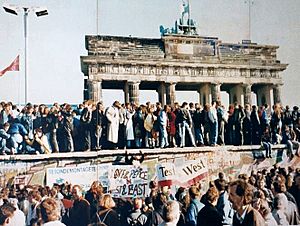
After the 1970s, Europe faced economic challenges. This led to the creation of the Single European Act, which aimed to create a single market by 1992. This made it harder for countries outside the EU to trade easily.
Austria, Finland, and Sweden had been neutral during the Cold War. This meant they couldn't join an organization that was developing a shared foreign policy. But when the Cold War ended in 1989, this obstacle was removed. On October 3, 1990, East Germany joined West Germany, which was already an EU member, so East Germany became part of the EU without increasing the number of member countries.
In 1993, the Community became the European Union with the Maastricht Treaty. New rules, the Copenhagen criteria, were set for countries wanting to join. These rules said a country must be a democracy, have a free market, and be ready to adopt all existing EU laws. On January 1, 1995, Austria, Finland, and Sweden joined the EU. Norway's people voted against joining again.
Eastern Enlargement
In the late 1980s, the Soviet Union allowed countries in Central and Eastern Europe to become free. These countries wanted to strengthen their new democracies by joining Western organizations like the EU and NATO. The EU was also seen as key to their economic success.
After some time, the EU agreed to talks with ten countries. On May 1, 2004, eight Central and Eastern European countries (Czech Republic, Estonia, Hungary, Latvia, Lithuania, Poland, Slovakia, and Slovenia), along with two Mediterranean countries (Malta and Cyprus), joined the EU. This was the largest expansion in terms of the number of countries and people.
Because these countries were less developed, some older EU members were concerned. Some countries, like the UK, immediately opened their job markets to citizens from these new member states. Others put temporary limits on people working in their countries.
Later, Romania and Bulgaria, which were not quite ready in 2004, joined on January 1, 2007. Like the 2004 members, their citizens faced some temporary work restrictions in older EU countries until 2014.
Western Balkans Enlargements
In 2003, the EU decided that bringing the Western Balkans countries into the EU was a top goal. These countries, which emerged after the break-up of Yugoslavia, have been given a clear path to apply for membership.
Croatia joined the EU on July 1, 2013. Albania and several countries that were once part of Socialist Federal Republic of Yugoslavia have all made joining the EU a main goal for their foreign policy.
Timeline
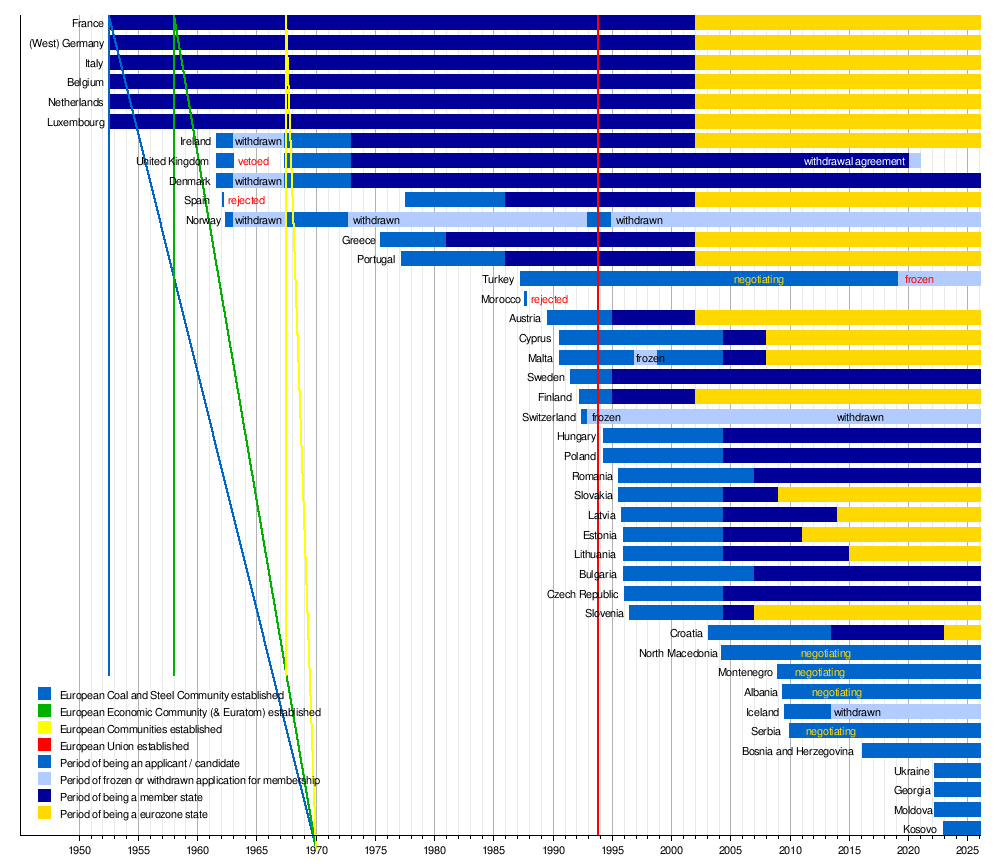
Countries That Might Join the EU
Countries Currently Working to Join
The EU's rules say that any European country that respects freedom, democracy, human rights, and the rule of law can apply to join. The Copenhagen criteria (explained above) set out the conditions. Countries in the Western Balkan region have been given special attention and a clear path to membership since the conflicts there in the early 1990s.
Currently, Montenegro (since 2012), Serbia (since 2014), Albania (since 2020), North Macedonia (since 2020), Moldova (since 2024), and Ukraine (since 2024) are all in talks to join. Talks with Turkey started in 2005 but have been paused since December 2016 due to concerns about democracy and rights.
Montenegro is the furthest along in its talks and hopes to join the EU by 2028.
Bosnia and Herzegovina and Georgia were officially named candidate countries in December 2022 and December 2023, respectively. They need to complete more reforms before they can start formal membership talks. Kosovo applied in December 2022. For Kosovo to become an official candidate, all EU countries would need to agree, but five EU countries do not recognize Kosovo's independence.
EU's Plan for New Members
In February 2018, the European Commission shared a plan for the six Western Balkan countries. This plan suggested that all six could join the EU after 2025. A summit in May 2018 focused on helping these countries join, including improving security and connections in the region.
The EU often refers to these countries as "partners" because not all EU members recognize Kosovo as a fully independent state. The EU wants to offer a clear path for all six partners to join, each at their own speed and with their own specific needs.
After the 2022 Russian invasion of Ukraine, Ukraine, Moldova, and Georgia applied to join the EU. The European Parliament quickly voted to support Ukraine's application. In June 2022, the European Commission suggested that Ukraine and Moldova become candidates, and Georgia become a potential candidate, needing to meet certain conditions like improving education, infrastructure, and fighting corruption. The European Council approved these recommendations.
On December 14, 2023, the European Council officially made Georgia a candidate country and agreed to start membership talks with Ukraine and Moldova. They also said that talks with Bosnia and Herzegovina would be reconsidered once certain conditions were met. However, on July 9, 2024, the EU paused Georgia's path to joining because of a new "foreign influence" law that some fear might limit democratic freedoms.
Other Countries That Might Join
Armenia
On March 12, 2024, the European Parliament stated that Armenia meets the requirements to apply for EU membership. On March 26, 2025, the Armenian parliament approved a plan to start the process of joining the EU.
Countries That Stopped Trying to Join
Several countries have applied to join the EU in the past but are no longer actively pursuing membership:
- Norway completed membership talks twice, in 1972 and 1994, but its people voted against joining in national referendums both times. Its application is currently paused.
- Switzerland applied in 1992 but later paused its application. It officially withdrew its application in 2016.
- Iceland applied in 2009 after an economic crisis but officially withdrew its application in 2013 after a new government was elected.
See also
 In Spanish: Historia de la membresía de la Unión Europea para niños
In Spanish: Historia de la membresía de la Unión Europea para niños
- Accession Treaty of Spain to the European Economic Community
- Eastern Partnership
- Enlargement of the African Union
- Enlargement of the eurozone
- Enlargement of the United Nations
- Enlargement of NATO
- Euronest Parliamentary Assembly
- European Economic Area
- European Free Trade Association
- European integration
- Foreign relations of the European Union
- Potential enlargement of the European Union
- Schengen Area
- Treaty of Accession 1994
- Treaty of Accession 2003
- Treaty of Accession 2005
- Treaty of Accession 2011
- Union for the Mediterranean
- Withdrawal from the European Union


